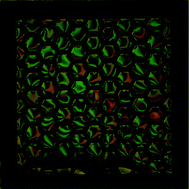Microfluidic sensing devices employing in situ-formed liquid crystal thin film for detection of biochemical interactions†‡
Abstract
Although biochemical sensing using liquid crystals (

* Corresponding authors
a
Department of Electrical and Computer Engineering, University of Wisconsin-Madison, 1415 Engineering Drive, Madison, WI 53706, USA
E-mail:
hongrui@engr.wisc.edu
Fax: 1-608-262-1267
Tel: 1-608-265-9418
b Materials Science Program, University of Wisconsin-Madison, 1415 Engineering Drive, Madison, WI 53706, USA
c Department of Chemical and Biological Engineering, University of Wisconsin-Madison, 1415 Engineering Drive, Madison, WI 53706, USA
d Department of Biomedical Engineering, University of Wisconsin-Madison, 1550 Engineering Drive, Madison, WI 53706, USA
Although biochemical sensing using liquid crystals (

 Please wait while we load your content...
Something went wrong. Try again?
Please wait while we load your content...
Something went wrong. Try again?
Y. Liu, D. Cheng, I. Lin, N. L. Abbott and H. Jiang, Lab Chip, 2012, 12, 3746 DOI: 10.1039/C2LC40462A
To request permission to reproduce material from this article, please go to the Copyright Clearance Center request page.
If you are an author contributing to an RSC publication, you do not need to request permission provided correct acknowledgement is given.
If you are the author of this article, you do not need to request permission to reproduce figures and diagrams provided correct acknowledgement is given. If you want to reproduce the whole article in a third-party publication (excluding your thesis/dissertation for which permission is not required) please go to the Copyright Clearance Center request page.
Read more about how to correctly acknowledge RSC content.
 Fetching data from CrossRef.
Fetching data from CrossRef.
This may take some time to load.
Loading related content
